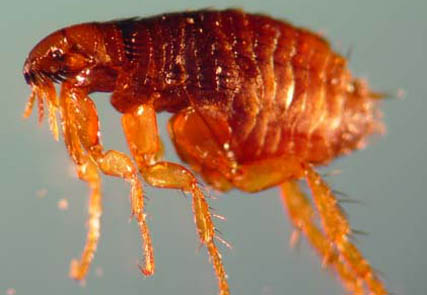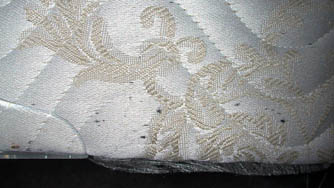Because of the media attention surrounding bed bugs, residents are often overly fearful that bed bugs are present and assume any small crawling insect must be a bed bug. Varied carpet beetle larvae are often mistaken for bed bugs as are ticks, fleas and other arthropods. Bed bug management is costly and should not be undertaken unless identification has been confirmed by a professional such as your local county Extension agent or specialist. One specialist estimates that 50% of submitted suspected bed bug specimens are not bed bugs.



Once identification has been confirmed, a pest management professional (PMP) should be contacted. A PMP has the tools needed for crack-and-crevice applications and access to a greater variety of insecticides than residents. Bed bug populations throughout the nation have been found to be resistant to pyrethroids which are the active ingredients in many of the insecticides available to the general public. Most PMPs will have a separate contract for bed bugs that clearly explains their responsibilities and their client’s responsibilities. The National Pest Management Association has released a list of bed bug best management practices that both the resident and PMP will find helpful. If a building is used for the temporary or permanent lodging of others (TDA 62-21-124), pesticides must be applied by someone under the direct supervision of a person licensed to apply pesticides. Pest management in hotels, motels, apartment complexes and other similar housing must be performed by a PMP. If you are a tenant, and your landlord is responsible for pest control, the landlord should be notified immediately if bed bugs are suspected..
One of the most thorough ways to manage bed bugs is to combine the commercial application of pesticides into cracks and crevices along with heat treatment and other non-chemical controls. Heat treatment for bed bugs should only be applied by trained professionals who have industrial equipment and can monitor temperatures to ensure the bed bugs are killed and to prevent fire hazards.
Pest management professionals will provide you a list of preparations that must be completed for bed bug management to be successful. Preparations may include washing and drying bedding, reducing clutter, sealing pipe penetrations and other cracks and crevices, bagging clothing after it has been run through the dryer, placing ClimbUp Insect Interceptors under bed legs and against walls, etc.
If hiring a professional is unaffordable, the following are several options that will help suppress bed bug populations, but not necessarily eliminate them. For more suggestions see Affordable Bed Bug Management?
- “Hunt and Peck” technique. Wearing gloves, use a flashlight and magnifying lens to see the bugs, and a credit card to move bed bugs out of cracks into the open. Bugs can be crushed or stuck to tape and put in a sealable plastic bag. Hot soapy water can be used, on appropriate surfaces, to clean up the bugs, their feces and stains.
- Vacuum. Bed bugs can move fairly quickly, so a vacuum may be more efficient at catching bugs than using the “Hunt and Peck” technique. Place a knee-hi stocking over the end of the vacuum tube and secure it with a rubber band prior to placing the attachment. Attaching the knee-hi is very important to prevent bed bugs from living in the hoses of in-wall systems. Vacuum cracks and crevices where bed bugs are likely to be found. When vacuuming is completed, remove the knee-hi, tie-off and discard in a sealable plastic bag. If a knee-hi is not available, empty the contents of the vacuum canister into a sealable plastic bag and discard the bag in an outdoor garbage can. Check the vacuum for live bed bugs and remove them to prevent moving bugs to other areas of the house.
- Steam. All stages of bed bugs will die within a minute when exposed to temperatures greater than 120 degrees F. Therefore, all stages of bed bugs will die when exposed to steam. Run the steamer over seams and other appropriate cracks and crevices. Steam should penetrate about 3/4 inch into fabric and over 2 inches into a gap. Steve Kells of the University of Minnesota provides many suggestions on using steam for bed bugs. A triangular head is usually effective. Do not use a narrow nozzle or pin-point steam nozzle as the velocity of the steam may blow the bed bugs away from the surface before they are killed. Surfaces can be monitored with an infrared thermometer and should reach 160 – 180 degrees F after the steamer has passed. If the surface is too hot, move the wand faster, and if the temperature is too low, move the wand over the surface more slowly. Personal safety and fabric precautions are also discussed.
- Washing and Drying Clothes. Place clothes that can be similarly laundered into a clean plastic bag and tie the bag. Empty clothes into the machine. Place all empty plastic bags into a clean bag and tie off prior to disposing. Wash and dry on the highest allowable setting according to fabric type. Dry clean only clothes can be placed in the dryer on medium to high setting for 20 to 30 minutes. Do NOT place dry clean only fabrics into the washer. Fold clothes and place directly into a clean bag. Keep clothes in a sealed bag until needed.
- Box Spring and Mattress Encasements. Encasements made specifically for bed bug management can be placed over mattresses and box springs. These encasements are modified to keep the zipper from backing off the stop. They deny bed bugs access to mattresses and box springs and seal them in if they are already present. Using intact, bed bug proof encasements should prevent the bed bugs inside the encasement from biting the sleeper. When denied a blood meal, these bed bugs will eventually die, but may require many months to do so. The light color of the encasement makes the bed bugs on the outside surface easy to detect. The encasements must be intact to be effective, so check them regularly for tears and ensure the zippers remain closed. See installation instructions from manufacturer to prevent tears.
- ClimbUp® Insect Interceptors and Other Monitoring Devices. ClimbUp Insect Interceptors, LightsOut Bedbug Detectors or similar devices can be placed under bed or furniture legs to aid detection of new infestations and protect against re-infestation. Pull beds away from walls and don’t allow bedding to touch the ground to prevent bed bugs from accessing the bed without climbing up the interceptor. Lightly dust wells with talc and replace the bandage tape as needed. Prevent pet hair from accumulating in the trap so it does not form a bridge for the bed bugs. Recent research indicates the ClimbUps can detect bed bugs when placed against walls also. See Monitoring Devices for other monitoring options.
- Insecticides. Many of the pesticides available to the general public are ineffective in controlling bed bugs due to their active ingredient and/or their method of application. “Bug bombs” do not control bed bugs because the bug is often protected in a harborage and not exposed to the insecticide. Diatomaceous earth (DE) can be effective when applied according to label directions, but DE is often misapplied by the general public. To kill bed bugs, DE should be applied in the cracks and crevices where bed bugs are found. Unfortunately, untrained applicators often place diatomaceous earth in exposed surfaces that could potentially pose a hazard to people and bed bug sniffing (and other) dogs.
To prevent future infestations… Be able to recognize all the fed and unfed stages (eggs, nymphs and adults) of a bed bug as well as their feces and shed skins. See Biology and ID.
When travelling, do the following:
- Store luggage away from beds. Some people store luggage in the bathroom or place it in a sealable plastic bag. Laptops give off heat and will attract bed bugs. When not in use, store a cool laptop in a sealable plastic bag.
- Inspect the hotel room before you unpack. You’ll need gloves, a flashlight and magnifying lens. Check behind the headboard, along the mattress seams, and other accessible cracks and crevices. Ask for another room if bed bugs are found.
- Check luggage for bed bugs before leaving the hotel.
- Wash and dry clothes immediately upon your return home.
- Leave luggage in a sealed bag until you have time to inspect and clean it, or heat treat it.
When acquiring used or rented beds, bedding, furniture, appliances and other items that may harbor bed bugs, inspect them before purchasing or bringing them to your home. New items should also be inspected prior to bringing them into the house. Put an end to “dumpster diving.” Don’t pick up furniture, bedding and appliances that have been placed next to a dumpster. Bed bugs may be one of the reasons these were placed there.
Inspect clothing, purses, backpacks and briefcases before entering the home. Purses, backpacks and briefcases can be left in sealed plastic bags during the day to prevent bed bugs from hitching a ride home with you.
Encasements made specifically for bed bug management can be placed over mattresses and box springs. The encasements deny bed bugs access to these items and the light color makes the bed bugs easier to detect. The encasements must be intact to be effective, so check them regularly for tears and ensure the zippers remain closed.
Reduce bed bug hiding places by sealing cracks and crevices and reducing clutter, especially under the bed.
ClimbUp Insect Interceptors, LightsOut Bedbug Detectors or a similar device can be placed under bed or furniture legs to aid detection of new infestations and protect against re-infestation. Pull beds away from walls and don’t allow bedding to touch the ground to prevent bed bugs from accessing the bed without climbing up the interceptor. Lightly dust the ClimbUp’s wells with talc and replace the bandage tape as needed. BlackOuts do not require talc. Prevent pet hair from accumulating in the trap so it does not form a bridge for the bed bugs.
Inspect the bed when changing sheets to detect bed bugs when the populations are still low.


For an illustrated guide on bed bug management steps, see the NY State IPM Program’s, Bed Bug Management – One Step at a Time series in English or Spanish.
Sources:
Vail, K. 2008. Don’t bring bed bugs home! http://eppserver.ag.utk.edu/Whats/wh2008/WHvol24issue1EPP779.pdf
Precautionary Statement
To protect people and the environment, pesticides should be used safely. This is everyone’s responsibility, especially the user. Read and follow label directions carefully before you buy, mix, apply, store or dispose of a pesticide. According to laws regulating pesticides, they must be used only as directed by the label and registered for use in your state.
Disclaimer
This publication contains pesticide recommendations that are subject to change at any time. The recommendations in this publication are provided only as a guide. It is always the pesticide applicator’s responsibility, by law, to read and follow all current label directions for the specific pesticide being used. The label always takes precedence over the recommendations found in this publication.
Use of trade or brand names in this publication is for clarity and information; it does not imply approval of the product to the exclusion of others that may be of similar, suitable composition, nor does it guarantee or warrant the standard of the product. The author(s), the University of Tennessee Institute of Agriculture and University of Tennessee Extension assume no liability resulting from the use of these recommendations.